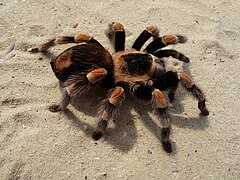Tarantula
| Tarantula | |
|---|---|
 |
|
| Mexican redknee tarantula | |
| Kingdom: | Animalia |
| Phylum: | Arthropoda |
| Subphylum: | Chelicerata |
| Class: | Arachnida |
| Order: | Araneae |
| Suborder: | Opisthothelae |
| Infraorder: | Mygalomorphae |
| Family: |
Theraphosidae Thorell, 1870 |
| Subfamilies | |
|
Acanthopelminae |
|
| Diversity | |
| 123 genera, 931 species | |
 |
|
Acanthopelminae
Aviculariinae
Eumenophorinae
Harpactirinae
Ischnocolinae
Ornithoctoninae
Poecilotheriinae
Selenocosmiinae
Selenogyrinae
Spelopelminae
Stromatopelminae
Theraphosinae
Thrigmopoeinae
Tarantulas comprise a group of large and often hairy arachnids belonging to the Theraphosidae of spiders, of which approximately 900 species have been identified. This article only describes members of Theraphosidae, although some other members of the same suborder are commonly referred to as "tarantulas". Most species of tarantulas are not dangerous to humans, and some species have become popular in the exotic pet trade.
Like all arthropods, the tarantula is an invertebrate that relies on an exoskeleton for muscular support. Like other Arachnida a tarantula’s body comprises two main parts, the prosoma (or cephalothorax) and the opisthosoma (or abdomen). The prosoma and opisthosoma are connected by the , or pregenital somite. This waist-like connecting piece is actually part of the prosoma and allows the opisthosoma to move in a wide range of motion relative to the prosoma.
Tarantulas sizes range from as small as a fingernail to as large as a dinner plate when the legs are fully extended. Depending on the species, the body length of tarantulas ranges from 2.5 to 10 centimetres (1 to 4 in), with leg spans of 8–30-centimetre (3–12 in). Leg span is determined by measuring from the tip of the back leg to the tip of the front leg on the opposite side. Some of the largest species of tarantula may weigh over 85 grams (3 oz); the largest of all, the goliath birdeater (Theraphosa blondi) from Venezuela and Brazil, has been reported to attain a weight of 150 grams (5.3 oz) and a leg-span of up to 30 centimetres (12 in), males being longer and females greater in girth.
...
Wikipedia
